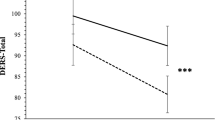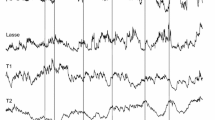Abstract
Individuals who fail to “workthrough” the emotional significance of a loss havetraditionally been assumed to suffer increased grief.Bonanno et al. (1995) tested this assumption byoperationally defining emotional avoidance as a verbal-autonomicresponse dissociation, or the reduced experience ofnegative emotion coupled with relatively high levels ofautonomic responsivity. In contrast to the traditional assumption, individuals who at 6 months hadshown verbal-autonomic dissociation had the mildestgrief course through 14 months. Verbal-autonomicdissociation was linked to initially high levels ofsomatic symptoms, but to low somatic symptoms at 14months. In the current investigation, we collectedfollow-up data on the same participants through 25months post loss and assessed additional health-related variables. Verbal-autonomic dissociation wasagain linked to the mildest grief course with noevidence of delayed grief. This predictive relationshipremained significant even when initial levels of grief were controlled. Further, no evidence was foundfor enduring or delayed health difficulties inassociation with verbal-autonomic dissociation.Implications for future bereavement research arediscussed.
Similar content being viewed by others
REFERENCES
Asendorpf, J. B., & Scherer, K. R. (1983). The discrepant repressor: Differentiation between low anxiety, high anxiety, and repression of anxiety by autonomic-facial-verbal patterns of behavior. Journal of Personality and Social Psychology, 45, 1334-1346.
Beck, A. T., & Steer, R. A. (1987). Manual for the Beck Depression Inventory. New York: Harcourt Brace Jovanovich.
Bonanno, G. A. (1998). The concept of "working through" loss: A critical evaluation of the cultural, historical, and empirical evidence. In A. Maercker, M. Schuetzwohl, & Z. Solomon (Eds.), Posttraumatic stress disorder: Vulnerability and resilience in the life-span (pp. 221-247). Göttinger, Germany, and Seattle, WA: Hogrefe & Huber.
Bonanno, G. A., & Eddins, C. (1997). Talking about the loss of a spouse: Dimensions of verbal disclosure and the prediction of long-term bereavement outcome. Manuscript submitted for publication.
Bonanno, G. A., & Keltner D. (1997). Facial expressions of emotion mediate the course of conjugal bereavement. Journal of Abnormal Psychology. 106, 126-137.
Bonanno, G. A., Keltner, D., Holen, A., & Horowitz, M. J. (1995). When avoiding unpleasant emotion might not be such a bad thing: Verbal-autonomic response dissociation and midlife conjugal bereavement. Journal of Personality and Social Psychology, 46, 975-989.
Bonanno, G. A., Siddique, H. I., Keltner, D., & Horowitz, M. J. (1996). Correlates and consequences of dispositional repression and self-deception following the loss of a spouse. Unpublished manuscript. The Catholic University of America, Washington, DC.
Bowlby, J. (1980). Loss: Sadness and depression (Attachment and loss, Vol.3). New York: Basic Books.
Brook, R. H., Ware, J. E., Davies-Avery, A., Stewart, A. L., Donald, C. A., Rogers, W. H., Williams, K. N., & Johnson, J. A. (1979). Overview of adult health status measures fielded in Rand's Health Insurance Study. Medical Care, 17, 1-119.
Cerney, M. W., & Buskirk, J. R. (1991). Anger: The hidden part of grief. Bulletin of the Menninger Clinic. 55, 228-237.
Creamer, M., Burgess, P., & Pattison, P. (1990). Cognitive processing in post-trauma reactions: Some preliminary findings. Psychological Medicine, 20, 1-7.
Deutsch, H. (1937). Absence of grief. Psychoanalytic Quarterly, 6, 12-22.
Draguns, J. G. (1993). Abnormal behavior in Chinese societies: Clinical, epidemiological, and comparative studies. Im M. H. Bond (Ed.), The handbood of Chinese psychology (pp. 412-428). New York: Oxford Universities Press.
Faschingbauer, T. R. (1981). The Texas Revised Inventory of Grief Manual. Houston, TX: Honeycomb.
Foa, E. B., Steketee, G., & Rothbaum, B. O. (1989). Behavioral-cognitive conceptualizations of posttraumatic stress disorder. Behavior Therapy, 20, 155-176.
Folkman, S., Lazarus, R. S., Greun, R. J., & DeLongis, A. (1986). Appraisal, coping, health status, and psychological symptoms. Journal of Personality and Social Psychology, 50, 571-579.
Freud, S. (1917/1957). Mourning and melancholia. In J. Strachey (Ed.). The standard edition of the complete psychological works of Sigmund Freud (Vol. 14; pp. 152-170). London: Hogarth Press.
Hansson, R. O., Remondet, J. H., & Galusha, M. (1993). Old age and widowhood: Issues of personal control and independence. In M. S. Stroebe, W. Stroebe, & R. O. Hansson (Eds.), Handbook of bereavement: Theory, research, and intervention (pp. 367-380). Cambridge, England: Cambridge University Press.
Harber, K. D., & Pennebaker, J. W. (1992). Overcoming traumatic memories. In S. A. Christianson (Ed.), The handbook of emotion and memory (pp. 359-388). Hillsdale, NJ: Erlbaum.
Holmes, T., & Rahe, R. (1967). The Social Readjustment Rating Scale. Journal of Psychosomatic Research, 11, 213-218.
Horowitz, M. J. (1976). Stress response syndromes. Northvale, NJ: Aronson.
Horowitz, M. J. (1989). A model of mourning: Change in schemas of self and other. Journal of the American Psychoanalytic Association, 38, 297-324.
Horowitz, M. J., Bonanno, G. A., & Holen, A. (1993). Pathological grief: Diagnosis and explanations. Psychosomatic Medicine, 55, 260-273.
Horowitz, M. J., Siegel, B., Holen, A., Bonanno, G. A., Milbrath, C., & Stinson, C. H. (1997). Diagnostic criteria for complicated grief disorder. American Journal of Psychiatry, 154, 904-910.
Horowitz, M. J., Wilner, N., & Alvarez, M. A. (1979). Impact of event scale: A measure of subjective distress. Psychosomatic Medicine, 41, 209-218.
Kastenbaum, R. J. (1995). Death, society, and human experience (5th ed.). Boston: Allyn & Bacon.
Keltner, D., & Bonanno, G. A. (1997). A study of laughter and dissociation: Distinct correlates of laughter and smilling during bereavement. Journal of Personality and Social Psychology, 73, 687-702.
Kleinman, A., & Kleinman, J. (1985). Somatization: The interconnections in Chinese society among culture, depressive experiences, and the meanings of pain. In A. Kleinman & B. Good (Eds.), Culture and depression: Studies in anthropology and cross-cultural psychiatry of affect and disorder (pp. 429-490). Berkeley: University of California Press.
Lazare, A. (1989). Bereavement and unresolved grief. In A. Lazare (Ed.), Outpatient psychiatry: Diagnosis and treatment (2nd ed., pp. 381-397). Baltimore, MD: Williams & Wilkins.
Lehman, D. R., Wortman, C. B., & Williams, A. F. (1987). Long-term effects of losing a spouse or child in a motor vehicle crash. Journal of Personality and Social Psychology, 52, 218-231.
Lindemann, E. (1944). Symptomatology and management of acute grief. American Journal of Psychiatry, 101, 1141-1148.
Lund, D. A., Casserta, M. S., & Dimond, M. F. (1989). Impact of spousal bereavement on the subjective well-being of older adults. In D. A. Lund (Ed.), Older bereaved spouses: Research with practical applications (pp. 3-15). New York: Hemisphere.
Lundin, T. (1984). Long-term outcome of bereavement. British Journal of Psychiatry, 145, 434-428.
Marmot, M. G., Smith, G. D., Stansfeld, S., Patel, C., North, F., Head, J., White, I., Brunner, E., & Feeney, A. (1991). Health inequalities among British civil servants: The Whitehall II Study. Lancet, 337, 1387-1393.
Marsella, A. (1979). Depressive experience and disorder across cultures. In H. Trandis & J. Draguns (Eds.), Handbook of cross-cultural psychology (Vol. 8) (pp. 237-290). Boston, MA: Allyn & Bacon.
Mawson, D., Marks, I. M., Ramm, L., & Stern, L. S. (1981). Guided mourning for morbid grief: A controlled study. British Journal of Psychiatry, 158, 185-193.
Mossey, J. M., & Shapiro, E. (1982). Self-rated health: A predictor of mortality among the elderly. American Journal of Public Health, 72, 274-279.
Murray, S. L., Holmes, J. G., & Griffin, D. W. (1996). The benefits of positive illusions: idealization and the construction of satisfaction in close relationships. Journal of Personality and Social Psychology, 70, 79-98.
Newton, T. L., & Contrada, R. J. (1992). Repressive coping and verbal-autonomic response dissociation: The influence of social context. Journal of Personality and Social Psychology, 62, 159-167.
Osterweis, M., Solomon, F., & Green, F. (Eds.). (1984). Bereavement: Reactions, consequences, and care. Washington, DC: National Academy Press.
Parkes, C. M. (1987). Models of bereavement care. Death Studies, 11, 257-261.
Parkes, C. M., & Weiss R. S. (1983). Recovery from bereavement. New York: Basic Books.
Pennebaker, J. W. (1989). Confession, inhibition, and disease. In L. Berkowitz (Ed.), Advances in experimental social psychology (Vol. 22, pp. 211-214). New York: Academic Press.
Rando, T. A. (1993). Treatment of complicated mourning. Champaign, IL: Research Press.
Raphael, B. (1983). The an atomy of bereavement. New York: Basic Books.
Raphael, B., Middleton, W., Martinek, N., & Misso, V. (1993). Counseling and therapy of the bereaved. In M. S. Stroebe, W. Stroebe, & R. O. Hansson (Eds.), Handbook of bereavement:Theory, research, and intervention (pp. 427-456.) Cambridge, England: Cambridge University Press.
Rosenthal, R., & Rosnow, R. L. (1985). Contrast analysis: Focused comparisons in the analysis of variance. Cambridge, England: Cambridge University Press.
Sanders, C. M. (1993). Risk factors in bereavement outcome. In M. S. Stroebe, W. Stroebe, & R. O. Hansson (Eds.), Handbook of bereavement: Theory, research, and intervention (pp. 255-270). Cambridge, England: Cambridge University Press.
Shuchter, S. R., & Zisook, S. (1993). The course of normal grief. In M. S. Stroebe, W. Stroebe, & R. O. Hansson, (Eds.), Handbook of bereavement: Theory, research, and interven tion (pp. 23-43). Cambridge, England: Cambridge University Press.
Siegel, B., Horowitz, M. J., Bonanno, G. A., & Holen, A. (1995). Improving gold standards: An empirical method for developing new DSM diagnoses. Unpublished manuscript, University of California, San Francisco.
Stansfeld, S. A., Smith, G. D., & Marmot, M. (1993). Association between physical and psychological morbidity in Whitehall II Study.Unpublished manuscript. University College and Middlesex Hospital School of Medicine, London.
Stanton, A. L., Danoff-Burg, S., Cameron, C. L., & Ellis, A. P. (1994). Coping through emotional approach: Problems of conceptualization and confounding. Journal of Personality and Social Psychology, 66, 350-362.
Stroebe, M., Gergen, M. M., Gergen, K. J., & Stroebe, W. (1992). Broken hearts or broken bonds: Love and death in historical perspective. American Psychologist, 47, 1205-1212.
Stroebe, M. S., & Stroebe, W. (1991). Does'grief work" work? Journal of Consulting and Clinical Psychology, 59, 479-482.
Stroebe, W., & Stroebe, M. S. (1987). Bereavement and health. Cambridge, England: Cambridge University Press.
Taylor, S. E. (1991). Asymmetrical effects of positive and negative events: The mobilization-minimization hypothesis. Psychological Review, 110, 67-85.
Taylor, S. E., & Brown, J. D. (1988). Illusion and well-being: A social psychological perspective on mental health. Psychological Bulletin, 103, 193-210.
Tseng, W. S. (1974). The development of psychiatric concepts of Chinese medicine. Archives of General Psychiatry, 569-575.
Velden, M., & Wolk, C. (1987). Depicting cardiac activity over real time: A proposal for standardization. Journal of Psychophysiology. 1, 173-175.
Weinberger, D. A., & Davidson, M. N. (1994). Styles of inhibiting emotional expression: Distinguishing repressive coping from impression management. Journal of Personality, 62, 587-613.
Weinberger, D. A., Schwartz, G. E., & Davidson, J. R. (1979). Low-anxious and repressive coping styles: Psychometric patterns of behavioral and physiological responses to stress. Journal of Abnormal Psychology, 88, 369-380.
Worden, J. W. (1991). Grief counseling and grief therapy: A handbook for the mental health practitioner (2nd ed.). New York: Springer.
Wortman, C. B., & Silver, R. C. (1989). The myth of coping with loss. Journal of Personality and Social Psychology, 57, 349-357.
Zisook, S., & Shuchter, S. R. (1991). Depression through the first ye ar after the death of a spouse. American Journal of Psychiatry, 148, 1346-1352.
Rights and permissions
About this article
Cite this article
Bonanno, G.A., Znoj, H., Siddique, H.I. et al. Verbal-Autonomic Dissociation and Adaptation to Midlife Conjugal Loss: A Follow-Up at 25 Months. Cognitive Therapy and Research 23, 605–624 (1999). https://doi.org/10.1023/A:1018784724315
Issue Date:
DOI: https://doi.org/10.1023/A:1018784724315




